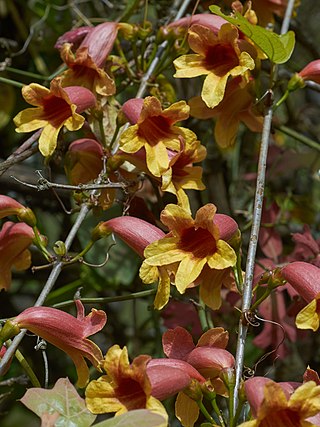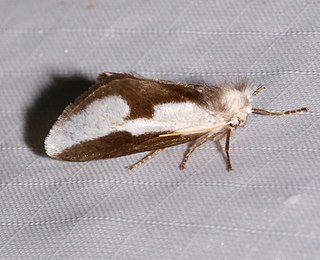
Bignonia capreolata is a vine commonly referred to as crossvine. The common name refers to the cross-shaped pattern revealed when the stem is cut; this pattern results from four radial wedges of phloem embedded within the stem's xylem. It is native to the central and southern United States. The vine climbs without twining but does produce tendrils. It produces long tubular flowers which are red and yellow and frequently have a mocha fragrance. The leaves are dark green to almost purple and produced as opposite pairs with terminal tendrils. The vine often climbs very high, with leaves only remaining on the uppermost portion of the plant. Crossvine can spread aggressively through stolons and may need to be managed in garden or domestic settings.

Norape is a genus of moths in the family Megalopygidae. The genus was erected by Francis Walker in 1855.

Fumaria capreolata, the white ramping fumitory or climbing fumitory, is an herbaceous annual plant in the poppy family Papaveraceae. It is native to Europe, western Asia and northern Africa and naturalised in southern Australia, New Zealand, and southern South America. Common names include also ramping fumitory, white fumitory, and white-flower fumitory.
Norape albilineata is a moth of the family Megalopygidae. It was described by Walter Hopp in 1927. It is found in Brazil.
Norape acuta is a moth of the family Megalopygidae. It was described by Walter Hopp in 1927. It is found in Costa Rica.
Norape draudti is a moth of the family Megalopygidae. It was described by Walter Hopp in 1927. It is found in Mexico.
Norape pampana is a moth of the family Megalopygidae. It was described by Walter Hopp in 1927. It is found in Argentina.
Norape truncata is a moth of the family Megalopygidae. It was described by Walter Hopp in 1927. It is found in Venezuela, Peru and Colombia.
Norape zikaniana is a moth of the family Megalopygidae. It was described by Walter Hopp in 1927. It is found in Brazil.
Norape damana is a moth of the family Megalopygidae. It was described by Walter Hopp in 1930. It is found in Brazil.
Norape dyarensis is a moth of the family Megalopygidae. It was described by Walter Hopp in 1929.
Norape plumosa is a moth of the Megalopygidae family. It was described by Arthur Gardiner Butler in 1877. It is found in Costa Rica, Panama and the Amazon region.

Norape virgo is a moth of the Megalopygidae family. It was described by Arthur Gardiner Butler in 1877. It is found from southern Texas and southern Arizona to Colombia.
Norape argyrorrhoea is a moth of the Megalopygidae family. It was described by Jacob Hübner in 1825. It is found in Argentina, Trinidad, Brazil, Guyana, Venezuela, Paraguay, Panama, Costa Rica and Mexico.
Norape cana is a moth of the Megalopygidae family. It was described by Paul Dognin in 1907. It is found in Colombia.
Norape miasma is a moth of the Megalopygidae family. It was described by Harrison Gray Dyar Jr. in 1910.
Norape puella is a moth of the Megalopygidae family. It was described by Francis Walker in 1855.

Norape tener, the mesquite stinger moth, is a species of moth in the family Megalopygidae. It was described by Herbert Druce in 1897. It is found in Mexico and the south-western US.
Norape vesta is a moth of the Megalopygidae family. It was described by William Schaus in 1892.
Norape xantholopha is a moth of the Megalopygidae family. It was described by Harrison Gray Dyar Jr. in 1914. It is found in Panama, Guatemala, Colombia and Peru.




